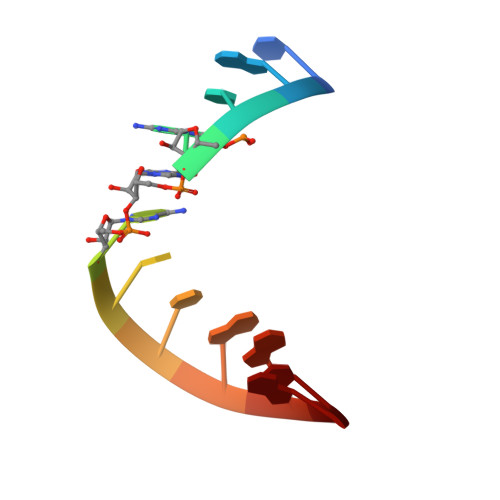Towards a comprehensive understanding of RNA deamination: synthesis and properties of xanthosine-modified RNA.
Mair, S., Erharter, K., Renard, E., Brillet, K., Brunner, M., Lusser, A., Kreutz, C., Ennifar, E., Micura, R.(2022) Nucleic Acids Res 50: 6038-6051
- PubMed: 35687141
- DOI: https://doi.org/10.1093/nar/gkac477
- Primary Citation of Related Structures:
7QSH, 7QTN, 7QUA - PubMed Abstract:
Nucleobase deamination, such as A-to-I editing, represents an important posttranscriptional modification of RNA. When deamination affects guanosines, a xanthosine (X) containing RNA is generated. However, the biological significance and chemical consequences on RNA are poorly understood. We present a comprehensive study on the preparation and biophysical properties of X-modified RNA. Thermodynamic analyses revealed that base pairing strength is reduced to a level similar to that observed for a G•U replacement. Applying NMR spectroscopy and X-ray crystallography, we demonstrate that X can form distinct wobble geometries with uridine depending on the sequence context. In contrast, X pairing with cytidine occurs either through wobble geometry involving protonated C or in Watson-Crick-like arrangement. This indicates that the different pairing modes are of comparable stability separated by low energetic barriers for switching. Furthermore, we demonstrate that the flexible pairing properties directly affect the recognition of X-modified RNA by reverse transcription enzymes. Primer extension assays and PCR-based sequencing analysis reveal that X is preferentially read as G or A and that the ratio depends on the type of reverse transcriptase. Taken together, our results elucidate important properties of X-modified RNA paving the way for future studies on its biological significance.
- Institute of Organic Chemistry, Center for Molecular Biosciences Innsbruck, University of Innsbruck, Innsbruck 6020, Austria.
Organizational Affiliation:


















